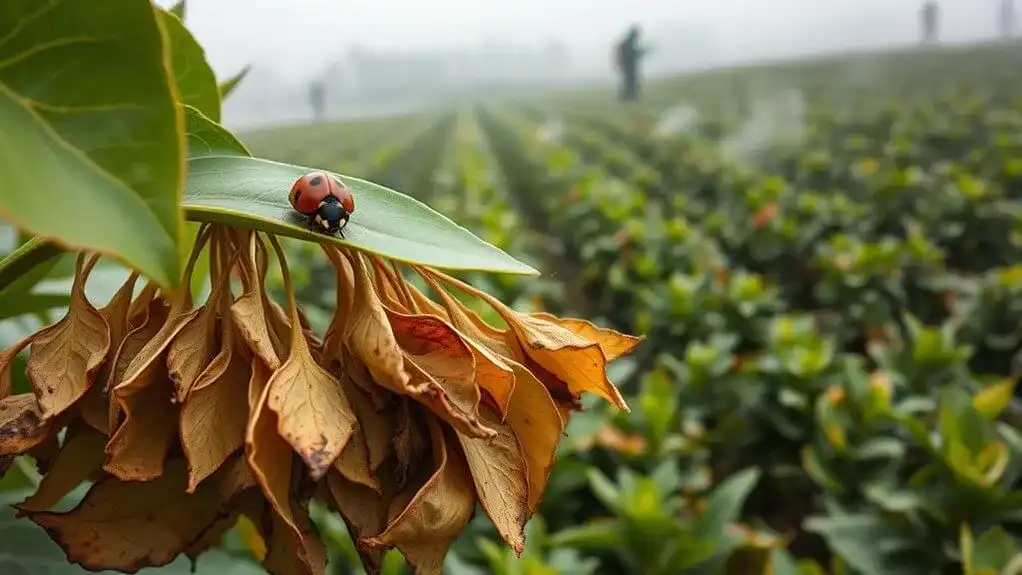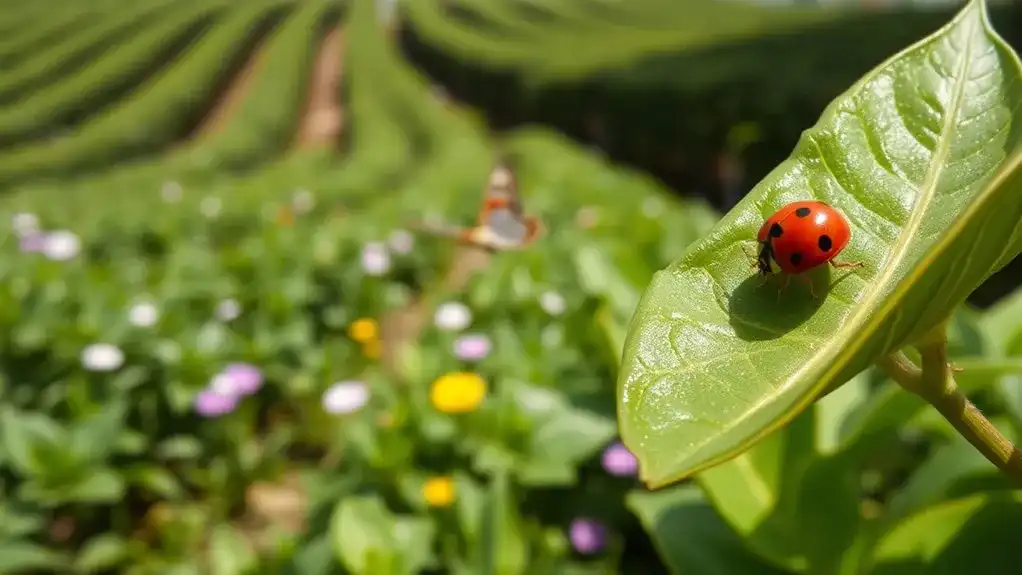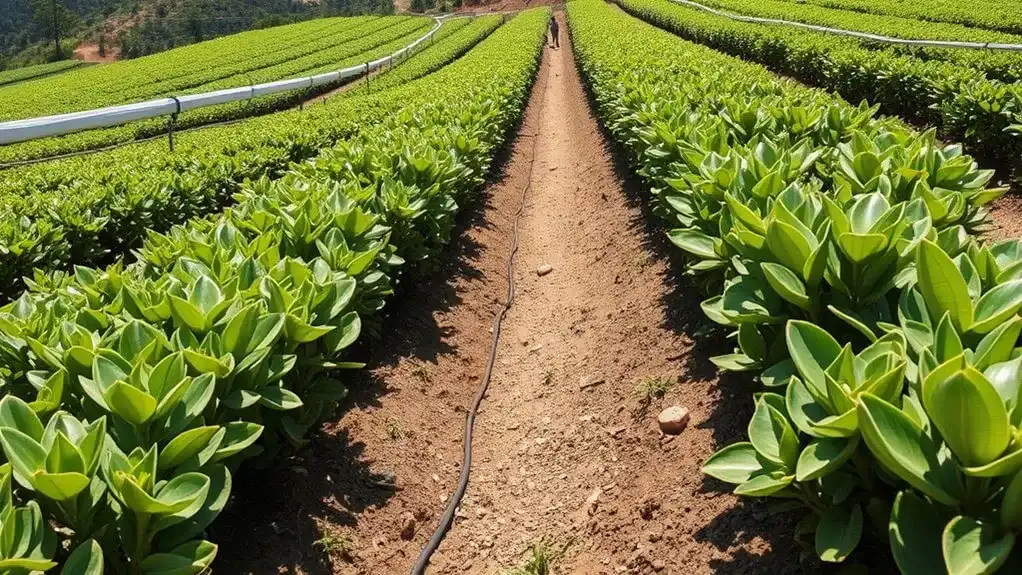Tea gardens face a critical environmental balance, with pesticide use ranging from 7.35 to 16.75 kg per hectare threatening ecosystems while also offering unique opportunities for biodiversity conservation. Well-managed gardens serve as essential sanctuaries, supporting diverse species and storing significant carbon – over 5,000 kg of CO2 per hectare annually. Through sustainable practices like integrated pest management and water conservation, tea gardens can transform from environmental challenges into models of agricultural harmony.
Key Points
- Current pesticide usage in tea gardens ranges from 7.35 to 16.75 kg per hectare, contributing to environmental concerns and food safety issues.
- Well-managed tea gardens support biodiversity through native shade trees and hedgerows, creating sanctuaries for diverse species.
- Tea plantations with organic practices store significantly more carbon (194.4 t ha^-1) compared to conventional systems (136 t ha^-1).
- The InVEST model helps measure environmental impacts by evaluating water yield, soil conservation, and habitat quality in tea gardens.
- Data-driven monitoring of environmental impacts enables better land use decisions and sustainable practices in tea cultivation.
Current Pesticide Challenges in Global Tea Production

While tea remains one of the world's most popular beverages, its production faces significant challenges due to heavy pesticide dependence. Tea gardens across major growing regions apply substantial amounts of synthetic pesticides, ranging from 7.35 to 16.75 kg per hectare, with broad-spectrum chemicals dominating usage patterns. Tea plantations typically host 380 fungal pathogens and numerous insect species that significantly impact crop health. Mountain-grown teas offer a safer alternative since their terrain naturally helps maintain lower pest populations. Without proper pesticide management, farms risk losing 10 to 40 percent of their harvests to pests and diseases. These practices raise serious health impacts as pesticide residues transfer directly to brewed tea. Recent investigations have revealed alarming levels of banned substances like DDT in 67% of tested Indian samples, while both Chinese and Indian teas show concerning toxicity levels. Despite pesticide regulations setting maximum residue limits, enforcement remains problematic. The economic pressure to prevent crop losses, estimated at 85 million kilos annually in northeast India alone, continues to drive chemical pesticide use, creating a complex challenge for the industry's environmental sustainability.
Nature's Balance: Biodiversity Benefits of Tea Gardens

Although conventional tea farming often prioritizes monoculture cultivation, well-managed tea gardens can serve as vital sanctuaries for biodiversity. These gardens demonstrate remarkable ecosystem stability through the integration of native shade trees, hedgerows, and riparian corridors that support diverse species and protect against environmental challenges. The presence of nitrogen-fixing bacteria in biodiverse soils naturally enriches the nutrients available to tea plants. Third-party certification programs have emerged as important drivers of sustainable agroecology in tea gardens worldwide. Global tea cultivation practices have evolved to include innovative approaches, such as migratory routes protection for elephants in Indian plantations.
The benefits of biodiversity enhancement in tea gardens extend beyond ecological preservation. Tea plantations managed through agroecological practices show improved resilience to climate changes, reduced dependency on chemical inputs, and better soil conservation. They also create economic advantages through decreased pesticide use and additional income opportunities for local communities.
Traditional tea agrosystems particularly excel at combining production goals with conservation, providing habitats for endemic species while maintaining significant ecosystem services like water retention and carbon storage.
Water Resource Management in Tea Cultivation

Because tea cultivation demands substantial water resources, efficient management practices have become essential for sustainable production. Water conservation strategies, including drip irrigation systems and mulching techniques, help minimize water waste while maximizing irrigation efficiency. Modern tea farmers are implementing precision agriculture tools and monitoring weather patterns to enhance water usage throughout the growing season. The maintenance of riparian buffer zones helps protect water quality by filtering agricultural runoff before it reaches nearby waterways. High levels of nitrogen runoff from fertilizers can severely impact local water quality if not properly managed. Tea plantations often rely on monoculture farming, which increases water consumption and puts additional strain on local water resources.
Key aspects of water resource management in tea cultivation:
- A standard cup of tea requires 34 liters of water to produce
- Rainwater collection systems enhance sustainable irrigation practices
- The global water footprint for tea consumption reaches 30 billion cubic meters annually
These practices not only conserve water but also contribute to better soil health and reduced dependency on synthetic inputs. Smart irrigation systems deliver water directly to the roots, preventing evaporation and ensuring ideal moisture levels for tea plants.
Carbon Storage Potential of Tea Plantations

Tea plantations serve as considerable carbon sinks, complementing their role in water conservation through natural carbon sequestration processes. In northeast India, tea bushes sequester over 5,000 kg of carbon dioxide per hectare annually, with shade trees contributing nearly 60% of the total carbon storage. Studies in China's Meitan County reveal that tea plantation area expanded dramatically over two decades, highlighting the growing importance of these agricultural systems.
Leguminous shade trees provide essential cover while improving soil quality through enhanced microbial activity. Organic farming practices greatly enhance these plantations' carbon storage capacity. The soil component holds 80% of the carbon stock, while shade trees, tea bushes, and litter make up the remainder. Remarkably, organic tea plantations store more carbon (194.4 t ha^-1) than conventional systems (136 t ha^-1). Mature tea bushes aged 25-30 years absorb more CO2, and high-yielding cultivars like TV23 demonstrate superior carbon assimilation. These findings highlight tea plantations' potential role in carbon trading and environmental service programs.
Sustainable Practices and Ecosystem Service Trade-offs

While sustainable practices in tea gardens offer numerous environmental benefits, they often involve complex trade-offs between ecosystem services. The implementation of sustainable methods, like organic farming and biodynamic production, directly impacts the balance between habitat quality and carbon storage. Agroforestry benefits include enhanced biodiversity and improved soil health, but careful planning is needed to optimize these outcomes. Integrating natural pest management through beneficial insects helps minimize environmental damage while maintaining crop protection. The transition to organic fertilizers has significantly improved soil quality in tea plantations.
Key environmental impacts of sustainable tea production include:
- Reduced pesticide use leading to improved ecosystem health
- Enhanced water conservation through efficient irrigation systems
- Increased carbon sequestration through integrated tree systems
Research using the InVEST model has shown that different land use structures greatly affect water yield, soil conservation, and habitat quality. As tea gardens continue to expand, finding the right balance between production needs and environmental preservation remains a critical challenge for the industry.
Conclusion
Tea gardens stand at a crossroads where productivity meets sustainability. Like a delicate balancing act, modern cultivation must weigh chemical interventions against ecological preservation. While pesticides remain a pressing concern, tea plantations offer promising opportunities for biodiversity conservation, water stewardship, and carbon sequestration. The future of tea farming lies in adopting practices that don't just protect yields but nurture the entire ecosystem's health.

